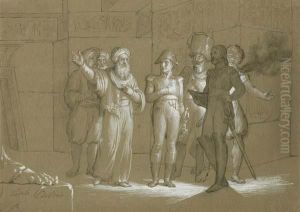Carlo Bellosio Paintings
Carlo Bellosio was an Italian painter known for his portraits and religious subjects. Born in 1771 in Finale Ligure, a town in the province of Savona, Liguria, Italy, he lived during a period of European art that was marked by transitions from late Baroque and Rococo to Neoclassicism.
Bellosio showed an early inclination towards art, and his initial training was under the guidance of the painter Carlo Giuseppe Ratti in Genoa. Ratti was known for his historical and religious paintings, and he was instrumental in nurturing Bellosio's talents. After this formative period, Bellosio traveled to Rome, which was then the epicenter of Neoclassical art. This exposure to the works of masters like Anton Raphael Mengs and the rich artistic environment of Rome further influenced Bellosio's artistic development.
During his career, Bellosio returned to his home region, where he became a prominent artist. His works were characterized by their clarity, controlled color palette, and the influence of Neoclassicism, which can be seen in his balanced compositions and idealized forms. Though not as widely known as some of his contemporaries, Bellosio contributed to the Italian art scene by painting altarpieces, portraits, and frescoes for local churches and noble families. His religious paintings often depicted scenes from the life of Christ and the saints, rendered with a sense of piety and emotional resonance that appealed to his patrons.
Bellosio's portraits are notable for their psychological insight and the delicate representation of his subjects, often capturing the status and character of the individuals he painted. His style in portraiture reflected a transition from the more ornate Rococo towards a simpler, more focused Neoclassical approach.
Carlo Bellosio passed away in 1849. Although he may not be as celebrated as some of his contemporaries, his work remains a testament to the transitional period in Italian art and provides valuable insight into the cultural and aesthetic shifts of his time. His paintings can still be found in churches and collections in Liguria and beyond, and they continue to be studied for their contribution to the artistic heritage of Italy.
